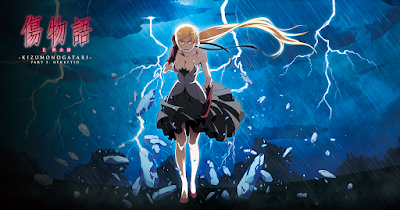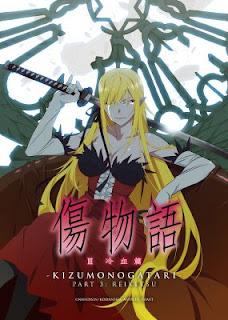The Monogatari (the Japanese word for "story") series is a long running light novel series written by Nisioisin and has been made into multiple anime throughout the years, the first of which was Bakemonogatari (Ghostory) which aired back in 2009. Animated by the creative minds of Shaft, all of the Monogatari anime sport the avante-garde animation style and story telling methods that have become synonymous with the studio. The "story" of Monogatari follows high-schooler Koyomi Araragi, a human who has recently reverted back from being a vampire, although he still retains his vampiric regenerative powers. Koyomi has encounters with various "apparitions" that have various effects on those around him such as robbing a girl of her weight, both literally and figuratively, or causing someone to remain forever lost and never reach their destination.
While each season told compelling stories with interesting characters, mind bending dialogue, and eye catching visuals, the origin story to it all, how Koyomi became a vampire in the first place and then reverted back, was never shown in animated form until recently. Eight years after Bakemonogatari first premiered on Japanese television, that origin story, Kizumonogatari (Wound Story) finally saw its conclusion in theaters. By this point a total of 86 episodes spanning across multiple seasons had aired of the Monogatari series. Assuming an average episode length of 25 minutes, that's nearly 36 hours of story. Kizumonogatari, by contrast, was split into a 3-part movie series with each part being 65-90mins in length. While prequels and origin stories are meant to give the viewer new insight into the story and world they already know, it's hard to imagine how much a mere 3 1/2 hours could effect perception of a 36 hour long beast. As it turns out, quite drastically. Kizumonogatari stands tall as the most provocative prequel for a series I have ever seen and has changed how I view the Monogatari series as a whole in ways I never thought possible.
(Mild spoilers for the movies and series ahead, but nothing too big)
Tsubasa, Oshino, and Shinobu (then called Kiss Shot Aceriole Heart Under Blade). These are the three primary characters involved in in Koyomi's tale during Kizumonogatari and naturally the ones most affected by its events. While we had seen quite a lot of Tsubasa and her feelings for Koyomi throughout the Monogatari TV series, they were never quite put into context. As a result, her feelings for Koyomi often came across as tepid, nothing more than a high school crush. Even during the story arc dedicated to her, Tsubasa Cat, the stress Tsubasa felt from her feelings being unreciprocated ultimately fell short of the straightforward, and strangely pure, nature Hitagi Senjougahara's love for Koyomi.
But then Kizumonogatari comes out and gives us that context. It gives us a reason for why Tsubasa loves Koyomi so and the movie goes to excruciating lengths to make that clear to the viewer. Koyomi saved Tsubasa, and Tsubasa saved Koyomi. They became special existences to one another where one could not exist without the other in a relationship that could only be described as having a perverse beauty. To put it simply, they were soul mates; a pair that seemed destined to be together. So when Hitagi came along in Bakemonogatari and took Koyomi for herself, suddenly it becomes hard to see her anything more than a homewrecker. Despite that, though, we still can't bring ourselves to hate Hitagi for it because she is also such a well done character that exhibits a dynamic strength. This relationship introduces yet another contradiction that the series is so well known for and causes a stabbing pain in the heart any time Tsubasa or Hitagi appear on screen.
While Oshino did ultimately resolve Koyomi's conflict in Kizumonogatari, it was far from ideal. "There is an outcome where you're all miserable," he said. While it was ultimately Koyomi's decision to do what he did, Oshino was the one who planted the idea in his head and he knew Koyomi would choose it. Oshino's whole job was to "keep the balance" and ending the events in such a way that only losers existed was the best option. Oshino could have easily kept this truth from Koyomi but he chose not to, thus condemning Koyomi to a bizarre, and possibly cruel, fate.
Finally there's Shinobu (who I will be calling thus for the sake of convenience), the central cause for everything that happened in Kizumonogatari. Throughout Bakemonogatari we would often see Shinobu curled up in the corner whenever Koyomi came to visit Oshino. Very little was ever said about her and Koyomi even said to each visitor he brought to simply ignore her. The viewer was also treated as a "visitor" and thus followed Koyomi's instructions, chalking Shinobu's existence up to being another part of the wacky story. None of the characters ever seemed to take her seriously, so why should we? Once again, Kizumonogatari gave us that reason that we had been waiting for for 8 years.
Shinobu suffered intense pain and anguish, both on a physical and mental level, and in the end she arguably wasn't even saved. Her wish was denied and she was forced to live as a diminutive shadow of her former self. The whole experience was obviously, and understandably, traumatizing for even a 500 year old vampire. With that knowledge in mind suddenly her shrunken form in the corner of a room becomes heartrendingly sad. Pitiful, pathetic, and wretched don't even begin to describe the emotions her presence evokes in Bakemonogatari after watching Kizumonogatari.
This makes the start of her recovery, however, all the more meaningful. When Shinobu finally began to talk for the first time in Nisemonogatari, it seemed like a semi-lazy plot device on Nisioisin's part to introduce a new character without actually introducing one. But now those words carry significance. They symbolize Shinobu's readiness to start moving past her trauma after grappling with it for an entire season. An entire season she spent curled in a ball, never speaking a word. The relationship she began to form with Koyomi thereafter turned into a thing of beauty. It became something truly special that transcended traditional friendship and love.
Going into the Kizumonogatari movies I didn't quite know what to expect. I knew I was probably in for some gorgeous animation and fight sequences and I also had an idea that I would be in for the head-turning and mind-bending story telling that Shaft is known all to well for. What I was not expecting was something so profoundly thought-provoking. It gave context for a series of stories that seemed to have none; that seemed to simply exist as a form of entertainment. I had always been content with simply going with the flow when it came to the Monogatari series, enjoying them piece meal as they came and went, never really desiring more or less. Ironically, though, it's the story that started it all that has me ravenously craving an ending to the saga. Kizumonogatari connects all the Monogatari's as one big story when before there was none. It forcefully pulls the viewer into its universe where they witness a picture form on a much grander scale than they could have ever imagined and for that I give the Kizumonogatari movies, and the Monogatari series as a whole, my highest regard.





No comments:
Post a Comment